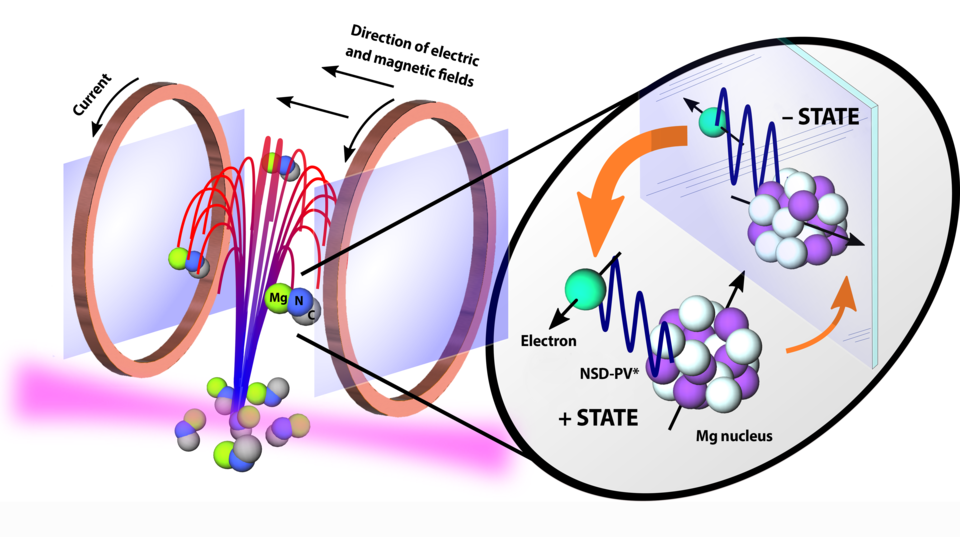
If you hold up five fingers in a mirror, and your reflection holds up four, that is a parity violation!
You can't see it. You can't feel it. But the substance scientists refer to as dark matter could account for five times as much "stuff" in the universe as the regular matter that forms everything from trees, trains and the air you breathe, to stars, planets and interstellar dust clouds.
Though scientists see the signature of dark matter indirectly in the way large objects orbit one another - particularly how stars swirl around the centers of spiral galaxies - no one knows yet what comprises this substance. One of the candidates is a Z' boson, a fundamental particle that has been theorized to exist but never detected.
A new proposed experiment could help scientists determine whether Z' bosons are real, in that way identifying a possible candidate for dark matter. To accomplish this task, researchers from the National Institute of Standards and Technology (NIST), the University of Groningen in the Netherlands, the Canadian particle accelerator center TRIUMF and other collaborators are working to make the most accurate measurements to date of a nuclear property that is extremely difficult to measure, called nuclear spin-dependent parity violation (NSD-PV).
The physical experiment - which has not been built yet - would have a fountain design similar to the atomic fountains that scientists currently use as the standard for timekeeping. However, instead of solitary atoms, the experiment would use molecules composed of three atoms each. Currently no one has built a molecular fountain with molecules that include more than two atoms each. In addition, unlike previous, similar approaches, the proposed method would focus on lighter atoms, such as carbon, which are easier to model than heavier ones, such as the cesium used in NIST fountain clocks.
The team's paper, published this week in Physical Review A, contains a proposal for the experiment as well as the best calculations to date of what measurements the researchers could expect to gather. In their new calculations, researchers were able to predict what the NSD-PV signal should be with an uncertainty of only 10% - a much higher accuracy than ever accomplished before, the researchers said. If the signal scientists eventually obtain is significantly larger than their calculations predict, it would potentially be a signature of new physics - physics that goes beyond the framework of our understanding of the universe.
"In this work, we combine our novel experimental techniques with our collaborators' state-of-the-art nuclear and molecular calculations, which opens up a path toward measuring some of the least well-known properties of fundamental particles that we are able to measure," said NIST researcher Eric Norrgard.
What's the Big Idea?
The NSD-PV effect that is the focus of this work is related to the weak force, one of the four fundamental forces of the universe. The weak force is responsible for radioactive decay and fusion, which transform one kind of atom into another. It also plays a part in the forces that keep electrons orbiting atomic nuclei.
Unlike the other fundamental forces, the weak force experiences something called parity violation, which was actually discovered at the National Bureau of Standards (NBS), the organization that eventually became NIST. Parity violation is when, broadly speaking, inverting the spatial coordinates of an object does not invert its behavior. (If you hold up five fingers in a mirror, and your reflection holds up four, that is a parity violation!)
In the case of the NSD-PV, researchers expect some kind of parity violation. What they are specifically looking for are aberrations in the parity violation signal - a measurement of the violation that is different from what they expect.
If their best mathematical models tell them the NSD-PV signal should be x, but their best measurements show them that the signal is actually y, then that can be a sign that the basis for the models is incorrect - which can indicate that the universe works differently from how we thought. That's the importance of measuring the NSD-parity violation.
Most groups measuring the NSD-PV look at systems where the effect should be largest, in relatively heavy atoms - atoms with a greater number of protons and neutrons. Examples are the metals cesium (55 protons) and barium (56 protons).
But even using heavy atoms, the effect still so small that only one team in the 1990s was able to see any signal at all.
The Dutch, TRIUMF and NIST researchers and collaborators decided to take different approach. What if they looked for the effect in lighter atoms instead?
A Unique Approach
Heavy atoms have more neutrons, protons and electrons, and this makes it difficult to calculate their behavior. By looking at lighter, simpler atoms, scientists can model the system with higher accuracy. This means that although the researchers will be looking for a smaller effect, they can be more certain when they see it that it is unexpected.
To make their calculations, researchers focused on three-atom molecules formed from combinations of the relatively light elements beryllium (4 protons), carbon (6 protons), nitrogen (7 protons), and magnesium (12 protons). For the proposed physical experiment, scientists will manipulate these molecules using a fountain design.

Physicists have been working with atomic fountains for decades. They are such a robust technology that they serve as the standard for timekeeping around the world. To make a fountain, researchers use lasers to cool atoms until they almost stop moving. Then scientists use magnets to shoot the stationary atoms upward in vacuum. When they reach the top of their arc, gravity pulls them back down.
While they are being manipulated in this controlled way, the atoms are probed by another laser that causes them to fluoresce. Effectively, scientists can tell what quantum state the components of the molecules are in based on what color of light they give off while being probed.
The proposed study will be similar, except that instead of single atoms the fountain will manipulate three-atoms molecules.
Performing the experiment itself will be complicated - very complicated, Norrgard said, since trapping three-atom molecules is still well beyond state of the art. Still, researchers are willing to deal with the added complication, as the NSD-PV signal in molecules is expected to be roughly a trillion times larger than in individual atoms.
"Right now at NIST, we are working to cool and trap chemically similar diatomic two-atom molecules, which is still very hard!" Norrgard said. "But the techniques, equipment and experience needed to trap diatomic molecules will help inform us on how to trap large molecules and enable us to perform the measurement," which could get scientists one step closer to determining whether Z' bosons exist.






